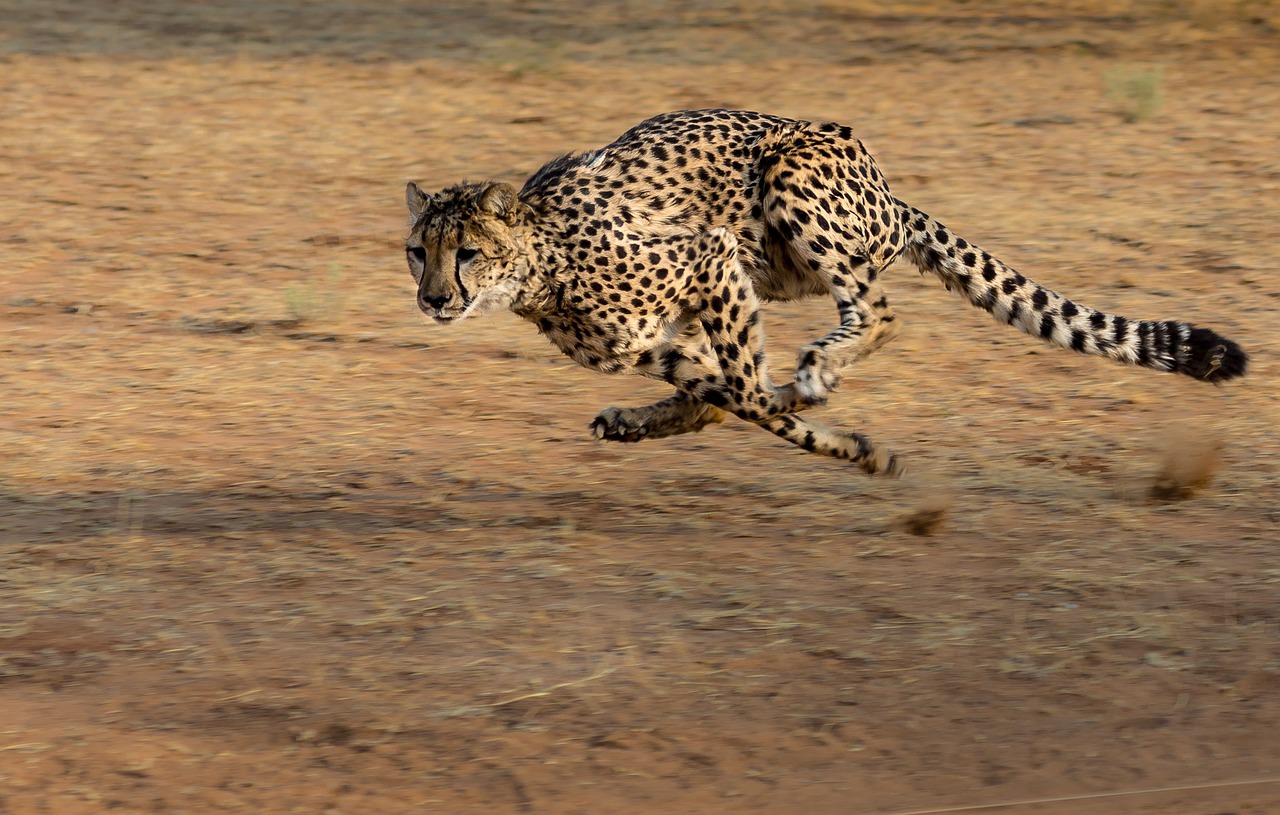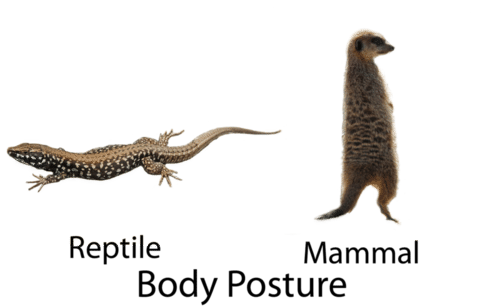16.41 哺乳动物的劳动 -- -- 高级
章节大纲
-
What allows this cheetah to be so fast?
::是什么让这只猎豹这么快?Do you think it has something to do with the placement of the limbs? Well, it does. Look closely at the cheetah's body. Can you describe why it is so fast?
::你觉得这和四肢的放置有关吗?Locomotion in Mammals
::哺乳动物的劳动Mammals are noted for their diversity of modes of locomotion, or ways of moving about. Mammals are also noted for their ability to move rapidly. Generally, the limbs of mammals are very mobile and capable of rotation. Another feature of mammalian limbs is their placement beneath the body rather than out to the sides of the body, as in lizards and most other . This is illustrated in Figure . Different mammals may have specialized limbs or other structure for running, hopping, climbing, flying, or swimming.
::哺乳动物因其运动方式或移动方式的多样性而备受注意。哺乳动物也备受注意,因为它们能够迅速移动。一般而言,哺乳动物的四肢非常流动,能够旋转。哺乳动物的四肢的另一个特征是放在身体下面,而不是放在身体的两侧,如蜥蜴和其他大多数动物。图中说明了这一点。不同的哺乳动物可能有专门的四肢或其他结构来跑步、购物、爬树、飞翔或游泳。Mammals differ from reptiles in the placement of their limbs. In mammals, the limbs are generally under the body rather than out to the side of the body. This enables many mammals to hold their bodies upright.
::哺乳动物与放置肢体的爬行动物不同,在哺乳动物中,肢体一般在身体下,而不是在身体的侧面,这使许多哺乳动物能够直立地保持身体。Limb Positions in Reptiles and Mammals. The sprawling limbs of a reptile keep it low to the ground. A mammal has a more upright stance.
::爬虫类和哺乳动物的林木姿势,爬虫类的无孔不入的四肢将它压低在地上,哺乳动物的姿势更直直。Terrestrial Mammals
::陆地哺乳动物, or ground-living, mammals have a variety of modes of locomotion. For example, some are specialized for running and others for jumping. Some mammals that are specialized for running, such as horses and deer, have hooves on their feet. Hooves are strong and resilient, allowing to move quickly over almost any type of ground. Many mammals that are specialized for jumping, such as rabbits and kangaroos, have relatively large and powerful hind legs, which let them hop with relatively little effort (see the kangaroo in Figure ).
::哺乳动物有多种运动模式,例如,有些是专门跑步的,有些是专门跳跃的。有些专门跑步的哺乳动物,例如马和鹿,脚上有蹄子。软木坚韧不拔,可以快速移动到几乎所有类型的地面上。许多专门跳跃的哺乳动物,例如兔子和袋鼠,都有相对较大、强大的后腿,这使得它们很少努力地跳跃(见图中袋鼠)。These illustrations depict some of the ways that mammals move about, demonstrating how they have adapted to different modes of locomotion.
::这些插图描述了哺乳动物移动的一些方式, 展示了它们如何适应不同的运动模式。Arboreal and Flying Mammals
::阿波尔和飞行哺乳动物Arboreal , or tree-living, mammals typically have five fingers or toes on their hands and feet, which help them grasp the branches of trees. Certain arboreal , including many species of New World monkeys, have a prehensile tail , which is used like a fifth hand (see the spider monkeys pictured in Figure ). Brachiation , or swinging from branch to branch, is another method of locomotion in certain arboreal mammals. Brachiating mammals generally have long forelimbs that help them swing from one branch to another (see the gibbon in Figure ). Some arboreal mammals (such as the tarsier in Figure ) have large pads on their fingers to improve grasping. Other arboreal mammals have claws or well-developed nails to help them climb trees and grasp branches.
::哺乳动物通常在手脚上有五根手指或脚趾,有助于他们抓住树枝。某些亚马逊类动物,包括许多新世界猴子物种,尾巴有先发性,像第五只手一样使用(见图中的蜘蛛猴子)。腐蚀,或从树枝到树枝的摇动,是某些亚马逊类哺乳动物的另一种摇动方法。布拉奇类哺乳动物一般有很长的时间,可以帮助他们从一个树枝向另一个树枝摇动(见图中的刺)。一些亚马逊类哺乳动物(如图中的焦油)的手指上有大片垫子来改进抓捕。其他亚马猴哺乳动物有爪子或精密的指甲来帮助他们爬树和抓树枝。Bats (like the one in Figure ) are the only truly flying mammals. Other “flying” mammals, such as flying squirrels, are actually gliders. They climb trees and then glide from branch to branch or from branch to ground.
::蝙蝠(与图中的蝙蝠一样)是唯一真正的飞行哺乳动物。 其他“飞行”哺乳动物,如飞松鼠,实际上是滑翔机。 它们爬上树,然后从树枝到树枝或从树枝滑翔到地面。Aquatic Mammals
::水生哺乳动物Some mammals are fully or mostly such as manatees, whales, seals, walruses, and dolphins (shown in Figure ). These mammals have evolved many adaptations for life in the . For example, some have streamlined bodies to reduce drag when moving through the water, and they may have modified appendages , such as flippers instead of legs, to help them swim. Seals and walruses spend most of their time in the water, but they give birth to and nurse their young on land. Manatees, dolphins, and whales, on the other hand, are completely helpless out of water. They depend on water both for mechanical support and for insulation from cold. Because of the buoyancy provided by water, whales have evolved to be not only the largest mammals, but also the largest vertebrates of any class.
::有些哺乳动物完全或大部分是诸如甲状腺、鲸鱼、海豹、海象和海豚等哺乳动物(见图)。这些哺乳动物对生命进行了许多适应性的变化。例如,有些哺乳动物在水中移动时简化了身体以减少拖力,并可能修补了辅助动物,如脚部而不是腿部,以帮助它们游泳。海豹和海象大部分时间都在水中,但他们在陆地上生育和喂养年幼的动物。而甲状腺、海豚和鲸鱼则完全无助于水,它们依靠水来提供机械支持和冷冻。由于水的浮力,鲸不仅演变为最大的哺乳动物,而且成为任何种类中最大的脊椎动物。Summary
::摘要-
Mammals are noted for their diversity of modes of locomotion, or ways of moving about.
::哺乳动物因其运动方式或行走方式的多样性而备受注意。 -
Generally, the limbs of mammals are very mobile and capable of rotation.
::一般而言,哺乳动物的四肢非常机动,可以旋转。 -
Some mammals that are specialized for running, such as horses and deer, have hooves on their feet.
::一些专门用来跑步的哺乳动物,如马和鹿,脚上有蹄子。 -
Arboreal, or tree-living, mammals typically have five fingers or toes on their hands and feet, which help them grasp the branches of trees.
::哺乳动物通常手脚上有五根手指或脚趾,有助于他们抓住树枝。 -
Some mammals have also evolved fins and other adaptations for aquatic environments.
::一些哺乳动物还进化了鳍,并对水生环境进行了其他调整。
Review
::回顾-
How are the limbs of mammals different from those of reptiles?
::哺乳动物的四肢与爬行动物的四肢有何不同? -
Discuss how mammals have adapted to running or jumping.
::讨论哺乳动物如何适应运行或跳跃。 -
How are arboreal mammals adapted to their way of life?
::Arboreal哺乳动物如何适应其生活方式? -
What is brachiating?
::什么东西在充斥着?
-
Mammals are noted for their diversity of modes of locomotion, or ways of moving about.



